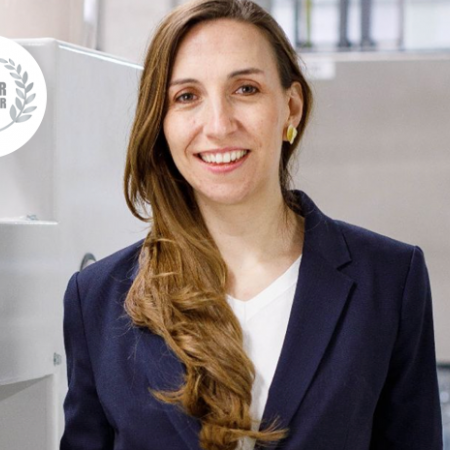May 6, 2022
Based in Switzerland, Bühler Group is a family-owned world leader in a huge variety of technologies that influence multiple aspects of everyday life. Within their vast food division, they’re concentrating on plant-based protein ingredients derived, in large part, from pulses. Kira Nash spoke with Alexandra Londoño of Bühler Group about the company’s partnerships, innovations, and excitement about a plant-based future.


Bühler is a technology leader in food processing, and we also have a non-food division covering everything from die casting to inks to our Leybold Optics. However, our food processing technologies division is the largest. We’ve been known for many years in milling, pasta processing, and even chocolate technology, but recently pulses have become a huge area of interest for us.
I've been working at Bühler for eight years. I’m from Colombia; I’m an industrial engineer with an MBA. I’ve gone through several different positions, and I’ve also been very close to the company’s strategic exercise; this is done every five years. Pulses processing is nothing new, but as a part of its future strategy, the Group decided to pursue this in a different way.
We had a big hub of pulse-processing technologies in South Asia, and in Bangalore — our South Asia headquarters — we had worked on many developments for pulse processing, so we already had a lot of knowledge and competence in the field. But three years ago, we chose to create a division here in Switzerland, not just with the objective of processing pulses into basic foods or staple foods but with the aim of extracting all of the valuable nutrients and processing pulses into protein. My role for the past three years has been first to create this new segment and now to lead it and our growing team.
Definitely. The demand is huge; the trend in alternative proteins is increasing with immense speed. We knew that we had some gaps in our portfolio that stopped us from covering the complete value chain, so our strategy overall has been to build strategic partnerships, and that has been part of my role. And since we created this division here in Switzerland, the growth has been tremendous. Four years ago, nobody believed that there would be such an enormous market for processing pulses into plant-based meat, plant-based burgers, plant-based beverages; people speculated that it was probably just hype. Now though, we can say with confidence that plant-based and pulse proteins are here to stay and that pulses are a great option to cover the protein needs of the world’s population now and in the future.
Yes, absolutely. Even during our strategic planning in 2015 (for 2020), we were already looking into it; Bühler focuses on innovation for a better world, and a better world is a sustainable world. And of course, along with sustainability comes the question of how we feed the projected 2050 population of 10 billion people. We now have the benefit, or the strategic advantage, of having the complete value chain from bean to burger thanks to our partnerships, so that was a big factor when we decided to pursue this direction of plant-based meat and meat alternatives.
Personally, I think that the pandemic has definitely been a driver in the consumption of plant-based meat. It’s just my perspective, but I see that firstly, people are getting more and more aware of the need to do something good for our planet. And in the developed markets, where there’s more spending capacity, people can make more apparently environmentally-friendly food choices. But beyond that, I think that the pandemic specifically acted as a sort of propellant to plant-based meat.
Plant-based meat itself is nothing new; it’s been around for years as extradites, TVP (textured vegetable protein), etc. We’ve sold extruders at Bühler for decades, but the first iteration of TVP and similar products was mainly made from soya, not from pulses like peas, lentils, chickpeas, and beans. And that first TVP generation was mainly made as meat extenders, so the aim was not to make environmentally friendly protein but rather, to make meat cheaper! The TVP would be added to beef sausages or pork sausages to reduce the meat content and therefore lower the price, but as it wasn’t much discussed and consumers weren’t so careful about reading labels back then, very few people knew about it.
Then there was the second generation of plant-based meats, but this was aimed mainly at purely vegan consumers. They were already not eating meat due to being centered on saving the cow or the pig — their veganism was for the sake of the animal in particular rather than the environment in general — so these second-generation products weren’t aiming at mimicking meat or the flavor of meat. Really, these products weren’t very good! They damaged the reputation of plant-based meats, and I would say that meat-eating consumers were a little scared of all of these vegan products!
But in the years following 2010, several new companies emerged with new ideas, innovations, and technologies, and the plant-based landscape began to change: slowly at first, but the sector was gaining momentum in the years up to 2020. These newcomers were using peas instead of chickpeas and aiming to appeal to a wider range of consumers, meat eaters included.
Even so, while it was definitely growing before the pandemic, there were still plenty of skeptical people saying that it was just a fad, just for vegetarians, too expensive. But then, things changed. I read that in the first two months of the pandemic, when everyone was stockpiling, really traditional meat consumers would go into supermarkets, see empty meat shelves, and think, “Actually, I’d rather eat some plant-based burgers than starve!” They bought these new foods, read the instructions, cooked their meals, and found that plant-based meats were not only good to eat, but good for the planet too.
I think it’s the pandemic that really gave rise to the whole new flexitarian population: people who aren’t willing to give up meat altogether but who want to have a more balanced consumption between meat and more sustainable alternatives.
I would say that our biggest achievement is definitely our ability to tap into the complete value chain from the farm to the fork. Four years ago, that wasn’t really possible; for example, we could do the cleaning, dehulling, and grinding of pulses, but we couldn’t do the critical steps of fine grinding or air classification for protein concentrates. So, we established fantastic partnerships that allowed us to move further along the process, and we can now go all the way to plant-based meat. These partnerships that have allowed us to provide a complete solution are vital, and they increase not only our value but our partners’ value too.
It definitely is. Bühler overall has an open innovation approach and open collaboration. We work very closely with academia, and we also sponsor MassChallenge: one of the biggest startup and innovation incubators. We’re also a part of Big Idea Ventures scouting very special startups who are innovating particularly in the field of alternative proteins. And for us, it goes far beyond just pulses or an ingredient for alternative proteins; Bühler is also looking into bio proteins and processing algae into proteins. We’re at the forefront of collaboration with startups, and ultimately, they’re the ones who give rise to new ideas and think outside the box.
Aside from the obvious business aims at any trade fair, it was really in my heart to be part of a GPC convention ever since we began striving for these new ingredients. Ultimately, the future of food has to be a united effort.
The past was heavily focussed on raw materials, on the trading part of the value chain, but my ultimate aim is to expand that perspective. We want to tell associates and participants that they already have a huge competitive advantage in this new landscape just from having the pulses, storing them, maybe doing some rough cleaning. We want to share insights, to help growers and producers make their current operations more future-oriented. We’re also looking toward how we can help to develop some kind of standard for the industry. With wheat, there are standards: you know exactly what you’ll get out of the mill depending on what you put in. But with pulse crops, these standards don’t exist yet, and yet they’re extremely important when it comes to proteins and other ingredients. We hope not only to inspire industry members about the exciting potentials for new business but also to bring about a united effort to make the equation a little more standard in the future.
I like to tell them that they’re sitting on gold! If you have the raw materials right now for pea isolate or pea concentrate, given the future’s clear direction, it’s like being the owner of a pile of gold.